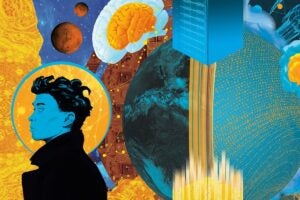
Imagine biting down on a juicy cheeseburger after a long day of yard work, or taking a swig of ice-cold water on a hot summer’s day. That immediate rush of euphoric bliss is the body’s way of saying, “Yes, please!”
Like a well-oiled machine, the brain is hard-wired to reward basic human needs like eating, drinking and procreating to ensure survival of the individual and species. But what if those reward responses were derailed by a toxic concoction of chemicals? According to psychology research at The University of Texas at Austin, that’s what happens when addicts attempt to satiate their need for cocaine.

With a $1.5 million grant from the National Institutes of Health and the National Institute on Drug Abuse, Juan Dominguez, assistant professor of psychology and neuroscience, is investigating the brain’s response to the euphoric effects of cocaine. With a focus on the dynamics between sex hormones and the brain’s reward system, he aims to delineate and map out where and how addiction occurs in the brain.
By targeting the cognitive mechanisms at work, his research could lead to new drug-therapy interventions for addiction.
His preliminary findings show that a cocaine “high” hijacks communication between the brain’s natural call for human needs and the satiation response. Testosterone and estrogen (sex hormones in both men and women) are key instigators in the body’s demand for “feel good” stimuli, Dominguez says. By turning up the arousal thermostat, these hormones prompt the brain to desire and enjoy activities such as eating and sex.

“Hormones have a natural, biological evolutionary factor and we didn’t evolve to take cocaine,” Dominguez says. “In much the same way that they magnify the pleasure of rewarding behaviors, they also heighten unnatural reward stimuli like cocaine.”
To illustrate how the reward system works, Dominguez says feel-good chemicals such as dopamine work like a voice in the brain. When pleasurable activity occurs, the voice shouts to the receptors and the body subsequently feels reinforcement. Cocaine, however, intensifies the reward response by causing the voice to continuously scream out to receptors. Without proper reception, the brain continues to activate the need for more, thus fueling the vicious cycle of addiction.
“It’s a harmonious process that ensures the human body gets what it needs to stay alive,” Dominguez says. “However, cocaine subverts that dialogue, causing the call the insatiable need for more to be augmented.”
Using rodents, Dominguez and members of his laboratory track patterns in hormone activation while the animals have sexual intercourse under the influence of cocaine. Through these experiments, he aims to pinpoint the areas of the brain that are most receptive to the hormones at work, and to see whether he can manipulate how the animals respond to the drug.
Although the study is still in its preliminary phase, Dominguez has already found a strong correlation between estrogen levels and cocaine addiction among females. According to his findings, estrogen does seem to augment the brain’s response to cocaine.

“Cocaine makes the reward response linger longer, and hormones enhance that effect,” Dominguez says. “During a female’s ovulation cycle when they are most sexually active this increase in hormone levels spurs their need to go out and seek a mate. During this process, the rewards for sex, food and drugs like cocaine are enhanced.”
Dominguez says this finding lends credence to a growing body of research on estrogen and drug addiction.
Dominguez says the ebb and flow of estrogen levels could heavily influence a person’s response to immediate pleasures such as drug use, sex and eating. However, estrogen’s hormonal counterpart, progesterone, counteracts those cravings.
Whether progesterone may work as an antidote to drug cravings remains to be seen, Dominguez says. But he is confident that his findings will eventually point to new drug-therapy interventions for addiction.
A better understanding of the brain’s reward circuitry is critical for grasping the basis of addiction and designing prevention strategies, Dominguez says.
“This research is really exciting because it’s like going back in time to better understand a present-day problem,” he says. “By studying how the brain responds to factors that help maintain and preserve survival of our species like reproduction we’re able to apply that knowledge to grasp the development of pathological conditions such as addiction.”
Banner image: Bigstockphoto.com/Eraxion



